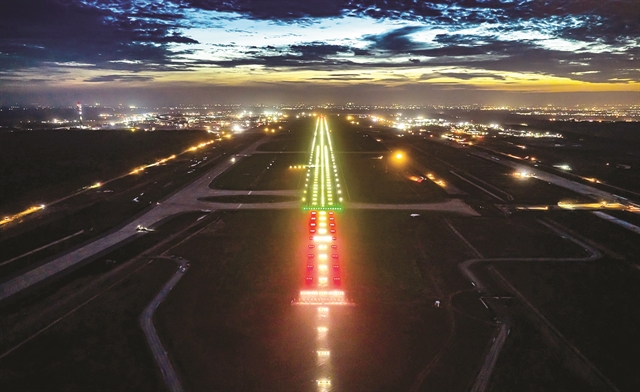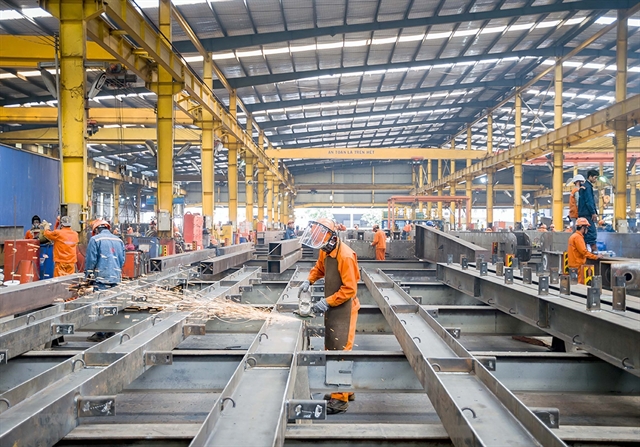 Society
Society


|
| Workers at a Japan-invested company in Tân Thuận Export Processing Zone in HCM City. — VNA/VNS Photo Danh Lam |
HCM CITY — Human resources, especially high-quality human resources, must be planned and it is essential to incorporate the human resource planning in a regular and long-term development strategy to promote socio-economic development and ensure national defence and security in the southeastern region.
Localities in the region need a strategy for training and effective use of post-training human resources, meeting the current demands for industrial, service, commercial, and tourism development.
At the Conference on Education and Training Development in the southeastern region until 2030, with a vision to 2045, recently organised by the Ministry of Education and Training in Bình Dương Province, Deputy Prime Minister Trần Hồng Hà directed localities to continue investing resources and overcoming difficulties to comprehensively develop the educational sector, as well as to train high-quality human resources.
The reality shows that countries are shifting their mindset and development methods from relying solely on natural resources to investing in intellectual resources.
He said that only investment in education and training can create a driving force for national development.
In the past ten years, from 2012 to 2022, the scale and network of educational institutions in the region have been invested in and developed synchronously and diversified in line with the actual conditions of each locality.
This has created favourable conditions and learning opportunities for the people, improving education and training levels, and developing human resources for the provinces and cities within the region and the country.
The region's higher education is increasingly affirming its role as a centre for training high-quality human resources in the country.
The entire region, which includes HCM City and five provinces managed by the central Government, Tây Ninh, Bình Phước, Bình Dương, Đồng Nai, and Bà Rịa-Vũng Tàu, has nearly 60 universities and over 300 vocational education institutions.
Each year, more than 76,000 graduates contribute to the region's supply of high-quality human resources.
The employment rate of graduates is nearly 87 per cent. The region's total number of trained workers aged 15 and over has reached nearly 30 per cent. The proportion of the population with a university degree or higher in the entire region is approximately 7 per cent.
As the economic locomotive and the largest centre for science and technology in the country and the southeastern region, HCM City aims to increase the proportion of trained labour to 87 per cent of the total workforce by 2025 and to 89 per cent by 2030.
By 2025, at least 10 per cent of public vocational education institutions will undergo quality accreditation based on international and ASEAN region's standards for their training programmes. This percentage will increase to at least 30 per cent by 2030.
Nguyễn Văn Lâm, deputy director of the HCM City Department of Labour, Invalids, and Social Affairs, stated that to achieve this goal, the city is focusing on training human resources to meet the demands of the labour market and the requirements of economic restructuring.
Training is closely linked to the overall plan for training internationally competent human resources in key sectors such as information technology, mechanics and automation, artificial intelligence, business administration, finance and banking, healthcare, tourism, urban management, and the shared university model.

|
| Workers at a construction company in An Hạ Industrial Zone in Bình Chánh District, HCM City. — VNA/VNS Photo |
The city is setting up connections between training and improving the quality of human resources at university and vocational education levels.
It selects and invests in developing some public vocational institutions according to the direction of high-quality schools.
It also develops criteria for evaluating and ranking vocational institutions in the locality as a basis for restructuring public vocational units. Furthermore, it encourages and provides incentives for the private sector to invest in vocational training.
Dr Nguyễn Đức Nghĩa, former deputy director of the Việt Nam National University-HCM City, recommended that universities and vocational institutions closely coordinate with the State agencies, businesses, and educational institutions to align supply and demand so this workforce will contribute to accelerating economic growth more effectively, especially in the current digital economy.
HCM City needs to gradually shift from relying on labour-insentive advantages to relying on a highly skilled workforce, prioritise attracting human capital, and transition from an investment-based economy to an economy based on intellectuals.
According to Master Nguyễn Chu Du from Union University, the southeastern region should review, rearrange, and plan the network of higher education and vocational institutions in alignment with the socio-economic development plans and the demands of the national labour market and regional and local needs.
Research from HCM City University of Economics shows that localities in the region need to concretise their plans for developing human resources in each sector and development project.
Localities need to identify training needs and attract human resources linked to prominent industries and the advantages of the locality through market demand surveys, workshops, and dialogues with relevant stakeholders, including businesses, local authorities, and training institutions. Businesses are the ones who understand the labour force's needs so that they can provide accurate and effective requirements for additional training and skill enhancement for workers.
The development of human resources must be closely linked to the optimal utilisation of resources to attract and retain high-quality human resources.
Depending on the operational characteristics of businesses in the locality, the plan for high-quality human resources should be regularly updated and adjusted to match both the demand and policies for attracting and utilising human resources.
To promote the training of human resources by businesses, the State and local authorities need to have supportive and encouraging policies for training institutions. According to the research, the State plays an intermediary role in connecting businesses and educational institutions by forecasting labour demand, providing information to training institutions, and facilitating meetings and discussions between businesses and training institutions regarding specific industries.
Minister of Education and Training Nguyễn Kim Sơn said the southeastern region needs to plan the education system, particularly the university level.
Currently, the distribution of universities in the region is uneven.
For example, HCM City has many universities, while Tây Ninh and Bình Phước provinces do not have any universities.
In addition, the region needs to promote socialisation, internationalisation, modernisation, digitisation, and universalisation of education. The Government invests and manages the education sector while opening a space for creativity and innovation to attract and mobilise social resources into education. Education policies should not differentiate between the public and private sectors.
The minister emphasised that the education sector must promote internal resources, focusing on attracting scientists and talents who are overseas Vietnamese and foreigners. Furthermore, there is a need to enhance the quality of foreign language teaching further, as it serves as a tool for Vietnamese labourers to integrate into the global workforce. — VNS